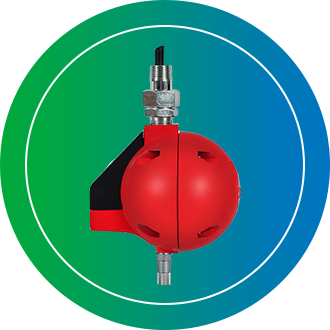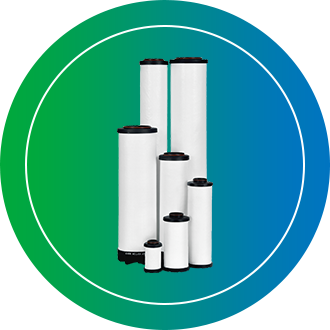Clean Compressed Air in Medical Applications
Medical compressed air is a clean, filtered, oil-free, and dry air supply meeting stringent standards like those from the United States Pharmacopeia (USP) and NFPA 99, used for direct patient respiration, as a carrier gas for anesthesia and aerosolized medications, and to power pneumatic surgical and dental tools. Unlike regular compressed air, medical-grade air must be free of contaminants to ensure patient safety and is typically generated on-site by specialized medical air compressors or supplied via pressurized cylinders.
What is Medical Compressed Air?
Purity and Composition: It is a purified air composed mainly of nitrogen and oxygen, but completely free of oil, moisture, odors, particulates, and other contaminants.
Regulatory Standards: It must adhere to strict quality criteria set by regulatory bodies, such as the USP for patient administration and NFPA 99 for medical devices.
Generation: It is produced by medical air compressors, which are designed to be oil-free and produce clean, dry air for medical applications.
Common Medical Applications
Respiratory Therapy: It provides breathable air for patients through ventilators, incubators, and other devices.
Aerosolized Medication Delivery: It powers nebulizers to deliver medications directly to a patient's lungs.
Anesthesia: It acts as a carrier gas during surgical procedures, used in conjunction with anesthetic agents to control a patient's breathing.
Powering Medical Tools: It is used to operate pneumatic instruments like surgical drills and saws.
Key Differences from Instrument Air
Direct Patient Use: Medical air is for applications involving direct human respiration, whereas instrument air is for powering medical devices unrelated to breathing.
Strictness of Standards: Medical air has more stringent purity and dryness requirements because it can be inhaled by patients, whereas instrument air also needs to be clean and dry but has less rigorous regulations.
How to Get Clean Compressed Medical Air
To obtain clean, compressed medical air, you must use specialized, multi-stage treatment systems including an after-cooler to cool hot air and reduce moisture, an air dryer to remove water vapor, and a series of filters (particulate, coalescing, and mist eliminator) to remove dust, oil, and other impurities. Oil-free compressors are also critical to prevent oil contamination, and a drain system is necessary to discharge collected water from the system.
Here are the key components and steps to achieve clean compressed air suitable for medical use:
1. Start with an Oil-Free Compressor
Purpose: To prevent oil from contaminating the air supply at its source. Oil-free screw or scroll compressors are ideal for medical applications.
2. Cool the Air (Aftercooler)
Purpose: To lower the temperature of the air immediately after it exits the compressor.
Process: Hot compressed air is passed through an aftercooler (which can be air or water-cooled) before further treatment. This process condenses water vapor from the air.
Benefit: Removing water in liquid form at this stage prevents filters from becoming less effective and reduces contamination.
3. Dry the Air (Air Dryer)
Purpose: To remove water vapor from the compressed air.
Types:
Refrigerant Dryers: Remove moisture when a specific, lower dew point is required.
Desiccant Dryers: Used to achieve even lower dew points for applications needing very dry air.
4. Filter the Air (Multi-Stage Filtration)
Purpose: To remove remaining contaminants.
Process: Air passes through a series of filters:
Particulate Filters: Remove dust, dirt, and solid particles.
Coalescing Filters: Filter out minute aerosols, oil, and other chemicals.
Mist Eliminators: Remove oil, water, and other particles, and can limit microbial growth.
5. Drain the System
Purpose: To automatically remove collected water and moisture from the system.
6. Use Certified Systems
For Medical Use: For medical applications, ensure the entire compressed air system is pre-certified to international regulations and quality standards, such as the European Pharmacopoeia and ISO 13485.
By implementing this multi-stage treatment process with the right equipment, you can reliably produce high-quality, clean compressed air for medical use.
Air Quality and Contaminants
✔ Particle-Free:
The air must be free of particles like dust and pollen.
✔ Moisture Control:
Extremely dry air is often necessary, particularly when in contact with hygroscopic (moisture-attracting) pharmaceutical products.
✔ Oil-Free:
Oil can enter the compressed air system from compressors, posing a serious contamination risk.
✔ Microbial Control:
Air must be sterile or germ-free for certain applications, requiring sterile filters or catalysis.
Why Choose Heng Sheng Filtration as Your Partner?
As a leading manufacturer of high quality compressed air and gas treatment equipment since 1998 in China.
✔ With over 27+ years of experience in research and development, production, and marketing.
✔Production facility covers a total of 20,000 square meters.
✔ Help you quickly find long-term and reliable supply resources
✔ Reduce your international procurement risks and costs
✔ Provide you with a wide variety of compressed air filtration and separation equipment to meet the varying needs of the market.
✔ Extensive experience with well-known air compressor brands.







